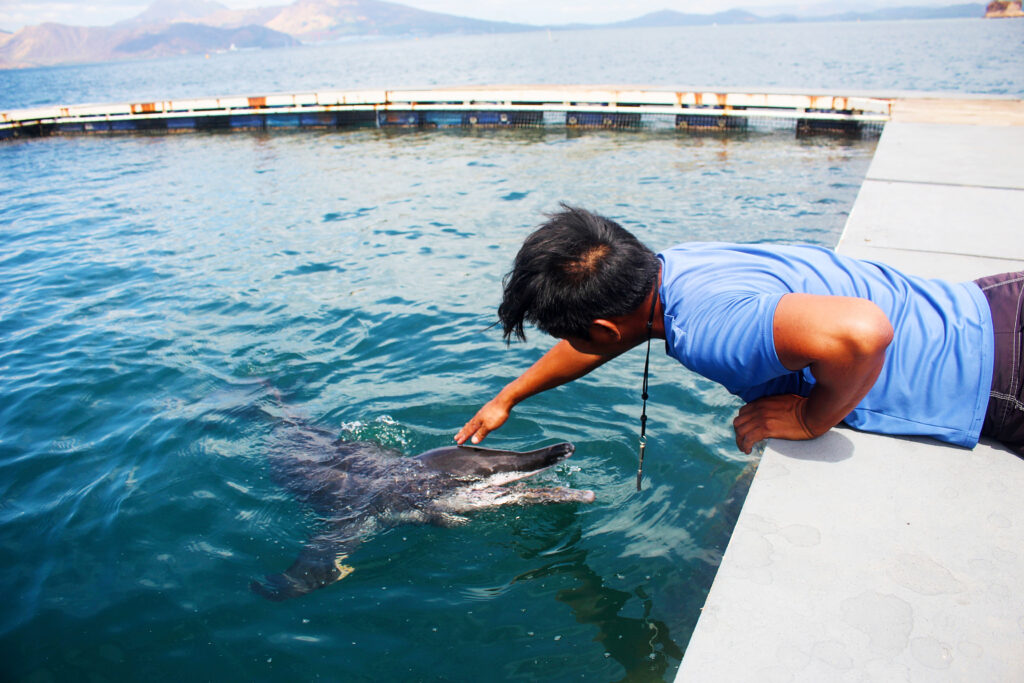SUBIC BAY FREEPORT — Local fisherfolks and officials in Agno, Pangasinan found a stranded male rough-toothed dolphin (Steno bredanensis) in Barangay Aloleng on 13 February.
Rescuers from the Bureau of Fisheries and Aquatic Resources Region 1 were called and immediately looked into the physical condition of the beached marine mammal they named Heart. They tried to release the male dolphin back to the sea, but Heart restranded the following day in Barangay Buboy, leaving the Philippine Marine Mammal Stranding Network concerned over its health.
“For whatever reason he returned to shore after only a day, it was still very fortunate that he ended up somewhere accessible to the stranding team. And in time,” PMMSN member and veterinarian Dr. Leo Suarez said.
Heart’s return to shore was an indication of his compromised health status.
“We will do this all over again if we must. A stranded dolphin sends us humans a message whether it survives this ordeal or not. Maybe by keeping him longer, even under long-term human care, we will be able to decipher that message and then share it to the rest of the world,” Suarez added.
Authorities relocated Heart to the rehabilitation pen of the BFAR 1 in Cariaz Island, Alaminos for intensive care and monitoring. Dr. Arnold dela Cruz of the Alaminos City Veterinary Office, together with the BFAR 1 and LGU personnel, transported the sick dolphin to the island on 14 February.
In Cariaz, a dedicated stranding team from the Ocean Adventure Marine Theme Park based in Subic Bay Freeport joined forces with the local authorities to provide round-the-clock observation on Heart. Concerns were raised due to Heart’s swimming pattern and the possibility of scoliosis, which experts attributed to the restricted swimming space in the pen.
When Heart’s condition improved, another attempt to release him was made on 18 February. However, Heart was reported stranded once again in San Fabian town, prompting another intervention from BFAR 1, maritime police and fisherfolks.
BFAR 1 official Dr. Hasmin Chogsayan, citing Heart’s recurring stranding and apparently deteriorating health, recommended the dolphin’s transfer to the Ocean Adventure’s facility, the only place in the Philippines where specialized care could be administered to the animal.
BFAR 1 facilitated Heart’s transfer in a bid to give it a fighting chance at survival. The dolphin arrived at Ocean Adventure in the early hours of 20 February.
Suarez, head vet at Ocean Adventure, commended BFAR 1’s efforts in helping out stranded marine mammals.
“They are able to do so much for these animals in need even with the limited resources and manpower. Somehow, we have to bridge the gap of available resources,” he said.
“And this is where other members of the Philippine Marine Mammal Stranding Network come in. Our network is functioning well to save these animals and we are getting better at what we do every time,” he added.
Heart is now under the dedicated care of Ocean Adventure’s animal care team, receiving tailored treatment, including antibiotics, liver support, electrolytes and supplements to address various health concerns. Additionally, physical therapy has been initiated to alleviate the mild scoliosis observed in Heart’s peduncle.
Subic Bay Marine Exploratorium Inc. president and CEO Robert Gonzaga said, “It is part of our mission to help local communities and the Philippine government, especially our partners at BFAR, in this endeavor. This collaborative effort underscores a shared commitment to safeguarding marine life and ensuring that our rescue attempts are successful.”
Gonzaga added, “At our Ocean Adventure facility, Heart will be given the best care possible by people who will go to great lengths and do whatever is necessary to save marine mammals in distress.”
SBMEI is the parent company of Ocean Adventure.
